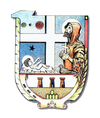Greccio
| Greccio | ||
|---|---|---|
| Comune | ||
| Comune di Greccio | ||
 |
||
|
||
| Location of Greccio in Italy | ||
| Coordinates: 42°27′N 12°45′E / 42.450°N 12.750°E | ||
| Country | Italy | |
| Region | Lazio | |
| Province / Metropolitan city | Rieti (RI) | |
| Government | ||
| • Mayor | Albertina Miccadei | |
| Area | ||
| • Total | 17 km2 (7 sq mi) | |
| Elevation | 705 m (2,313 ft) | |
| Population (2008) | ||
| • Total | 1,529 | |
| • Density | 90/km2 (230/sq mi) | |
| Time zone | CET (UTC+1) | |
| • Summer (DST) | CEST (UTC+2) | |
| Postal code | 02040 | |
| Dialing code | 0746 | |
Greccio is an old hilltown and comune of the province of Rieti in the Italian region of Lazio, overhanging the Velino river on a spur of the Monti Sabini, a sub-range of the Apennines, about 16 kilometres (10 miles) by road northwest of Rieti, the nearest large town.
The actual town of Greccio has been depopulating, and the administrative functions of the comune are now in the frazione of Limiti di Greccio.
Greccio was founded, according to tradition, as a Greek colony. They had fled or were exiled from their homeland as a result of war. They settled here for the natural protection it offered. Hence the name Greece, Grece, Grecce and finally Greccio. The earliest records date back to the Tenth and Eleventh centuries. The Benedictine Monk, Gregory of Catino (1062-1133) refers to the town of Greccio (curte de Greccia) in his work "Summary Farfense". From the remains of the ancient buildings it shows that Greccio became a fortified medieval castle surrounded by walls and protected by six towers fortress.
During the struggle with neighboring cities, the castle was destroyed in 1242 by the troops of Frederick II. They had a difficult history until 1799 when the town was destroyed and looted by the Napoleonic army.
Greccio was the place where, in December 1223, St. Francis devised the first living crib (in Italian: presepe). The idea was to discourage would-be pilgrims from going to Bethlehem, as it was a risky venture, the Holy Land being then under the control of the Turks. The tradition continues there to this day, and a memorial of St. Francis, the Santuario di S. Francesco, may be visited.
The village is surrounded by an oak forests. Trail lead through the forest to the summit of Mount Lacerone, 1,204 metres (3,950 ft) above sea level. Here St. Francis of Assisi, would retire in prayer and meditation in a hut protected by two hornbeam plants. In this same place, in 1792, by popular demand, it was built a memorial chapel dedicated to him, "the chapel".
The medieval village that preserves part of the pavement of the old castle (Eleventh Century) and three of the six towers. The parish church of San Michele Archangel is located next to the bell tower on top of a flight of steps and dates back to the fourteenth century. The church was built over a part of the castle. The church was destroyed and rebuilt several times. The church as a Nave and side chapels. Two of the side chapels, dedicated to St. Anthony of Padua and Our Lady Immaculate have paintings and frescoes of the Fifteenth and Sixteenth century. In the square, there is the Church of Santa Maria del Giglio from 1400. This church also is a single aisle or Nave. It has a central altar and two side altars, stucco Roman school with influences of Carlo Fontana. The high altar preserves, a fresco, which represents the Virgin and Child with Angels.
...
Wikipedia


